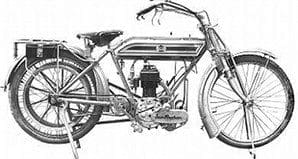
Sun 1911-33 and 1946-61 UK
The Sun Cycle and Fittings Company ought to be better known than it is, as many of us who own older British-made light and medium weight motorcycles can thank this company for enabling their machines to be built.
In addition to cycles, Sun Cycle and Fittings Company marketed a range of fitments including frame lugs, frame kits and even ready-made frames to the cycle trade. Once established in the cycle manufacturing business it seemed logical to the controlling Parkes family to offer the same fitments for the motorcycle trade, except on occasions Sun went one further, building complete motorcycles using proprietary engines (often Villiers) mounted in Sun-designed frames. The finished machines were branded to suit the trade customer.
The Parkes family established the Sun Cycle and Fittings Company Ltd in Aston Brook Street, Birmingham in 1885. Just around the corner, Norton later established their works in Bracebridge Street. Although Sun started in a small way with the Sun Spider ordinary cycle (penny-farthing) the Parkes family must have sensed an imminent explosion in the cycling market, encouraging them to invest heavily in an impressive frame making and lug casting plant with huge production capacity. For a few years Sun – and other 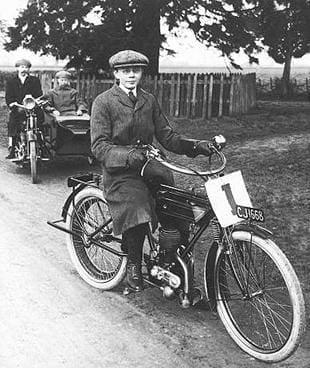 companies like them who’d chanced their arm – made hefty profits as the cycling market boomed. Chance often plays its hand with successful business ventures. After returning from America, Frank Baker established in 1911 his new Precision engine works, within shouting distance of the Sun plant, in Moorsom Street, with an expressed purpose to pull the rug from under established proprietary engine makers JAP of Tottenham, London. Although having the facilities to build proprietary engines, Baker couldn’t assemble complete machines without outside assistance.
companies like them who’d chanced their arm – made hefty profits as the cycling market boomed. Chance often plays its hand with successful business ventures. After returning from America, Frank Baker established in 1911 his new Precision engine works, within shouting distance of the Sun plant, in Moorsom Street, with an expressed purpose to pull the rug from under established proprietary engine makers JAP of Tottenham, London. Although having the facilities to build proprietary engines, Baker couldn’t assemble complete machines without outside assistance.
Although the precise history has long since been lost in the mists of time, in 1911 Sun began building complete motorcycles using Frank Baker’s Precision engines in Sun manufactured rolling chassis. Although not wanting to damage the prospective UK proprietary engine market by supplying complete motorcycles, Baker wasn’t opposed to extra income created by exporting complete machines, notably to Australia and South Africa. Since Baker couldn’t build complete machines at his Moorsom Street works it’s not unreasonable to have an educated guess and surmise these were built for him by Sun, which had the facilities to cast lugs, make frames and build complete machines, using additional bought in components where appropriate. This was the start of Sun not only building Sun motorcycles but also machines for rivals to be sold under the trade buyer’s brand.
Within a year Sun was offering a wide range of Precision engined models with engine options of 270, 499 and 599cc. Specification included hub gears, hub clutches or direct drive. These well-made and developed models hit the ground running – Sun at that time had tremendous resources from their profitable cycle making business. Their PR boys weren’t slow to point this out either, claiming in copy Sun had one of the largest and best equipped works in the world. In part a true claim, as Sun had taken over quite a chunk of Aston Brook – indeed, not just Aston Brook Street as even the Aston brook ran under one of Sun’s factory buildings – but most of it was flat out making cycles and cycle fittings. Soon, Sun added motorcycle fittings and frames/frame kits to the ever growing stock list.
During 1913 Sun added a 349cc Villiers four-stroke engine model to the catalogue which was soon replaced by a neat two-stroke model using the new 269cc Villiers engine – a unit which enabled a large number of small factories to build sound lightweight models. Like so many makers worldwide, Sun stopped motorcycle manufacture during WWI (Sun stopped c1916) to concentrate on other essential work.
War over, Sun continued with the bread and butter business of building good quality cycles and supplying components including frames or frame parts to rival makers. Rapidly, Sun returned to making frame lugs, kits and complete frames to the motorcycle industry.
The first post-WWI Sun models were powered by VTS engines although other proprietary engines including Villiers, JAP and Blackburne were to be employed in the coming years.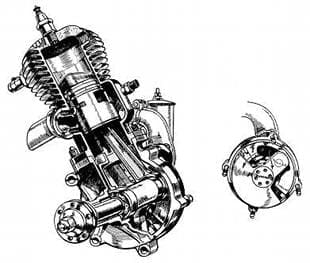
Early vintage VTS engines were of advanced design featuring a disc valve to control induction, a concept which was employed with great success over 30 years later, first by Walter Kaaden of MZ and then became universal for many two-stroke performance engines from Yamaha, Suzuki, Bridgestone and others.
Terry Duffy’s VTS (Valveless Two-Stroke Company) Broad Street, Birmingham forged links with Sun in 1913, leading initially to the Sun-Vitesse. The 269cc VTS engine of deflector piston design featured an overhung crankshaft and distinctively a deep sunken crankcase door on the unsupported side of the crankshaft. Certainly this design was relatively conventional but the next production VTS design was ground breaking.
A Mr Richards was responsible for the rotary valve two-stroke engine, again accorded the name Vitesse, which though it may or may not have been the first unit of this design, it was certainly the first to run successfully.
History books tell us Richards started work on this concept in autumn 1920 but the likelihood is it had been a drawing board or back-of-fag-packet idea for some years, quite possibly undergoing progressive redesigns.
Mr Richards’ 247cc (67 x 70mm) engine featured a full crankshaft with bob weights and outside flywheel, supported on conventional main bearings either side. Its disc valve was driven by pegs mounted on the crankshaft bob weight, with fuel by a single crankcase mounted carburettor. While Walter Kaaden’s disc valves fitted to his MZ racers were near wafer thin, Richards’ Vitesse disc valve was of about 1⁄4 inch steel.
Quite how long Richards spent developing his Vitesse engine is unclear – sources vary from a few months (claiming it went into production during late 1920) to others who state it wasn’t ready until the 1921 IoM TT. Whatever, two models were entered in the 1921 250cc class of the Junior TT. The race was for 350s but for the second year in succession there was a Junior 250 class. In a race won by Eric Williams 350cc AJS at over 52mph Messrs Norris and Bishop finished 28th and 29th at a steady 37-plus mph – 10th and 11th in the 250 class, which sounds a little more impressive. However, steady can be the only word to sum up their progress.
A year later and the machine now sported non-positive stop foot change Moss three-speed gearboxes and were again breaking fresh territory, boasting an aluminium cylinder barrel with cast iron liners. However, in the first ever Lightweight TT the uprated Sun Vitesses were slower than the previous year, with Gus Kuhn 12th at 35.56mph and Billy Lord 13th at under 35mph. The third Sun entry Bishop, retired.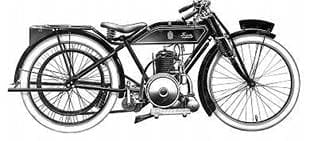
Brooklands motorcycle and car ace, speedboat racer, later importer of American Pontiac cars and German Zundapp motorcycles and the manufacturer of Ambassador motorcycles Kaye Don, circulated the Weybridge track at 70mph on a tweaked disc-valve Sun Vitesse. Despite this and success in trails where the ultra-reliable models excelled, Sun dropped the concept to concentrate on their cycle, frame and components business, while building other worthy and at times exciting motorcycles.
Although Richards’ disc valve concept was outstanding, his 1⁄4 inch steel discs didn’t make as good a seal as needed to close the port effectively. The world had to wait 30 years before Kaaden related disc valve and cylinder port timings to each other and to the capacity of the expansion chamber employed. Although this description is an over simplification of Walter Kaaden’s work at MZ, there is no doubting the sudden increase in power and performance he obtained. Suzuki, Yamaha et al won endless world championships directly thanks to the ground breaking work of Mr Richards at Sun and the brilliant Mr Kaaden, who well understood how to release the power from the disc valve two-stroke engine. In 1961 Kaaden’s 125cc MZ engine developed 25bhp which equates to 200bhp per litre, a world first.
While early post WWI Sun roadster models were built around the disc valve Vitesse two-stroke, by 1922 Blackburne and JAP power was taking over. This was supplemented by a range of Villiers two-stroke engined machines. As Sun motorcycle manufacture progressed at a steady rate, the Parkes family business continued with its cycle and cycle components business, as well as manufacturing frame components, frames and complete machines for rival brands.
Despite the effects of the depression which hit the motorcycle trade badly, Sun continued into the 1930s with a reduced range of models focussed around Villiers engines and up to 500cc side-valve and OHV JAP units. To secure every last sale, the Aston Brook firm even launched a very cheap economy 98cc model in 1931 using the Villiers Midget engine. Despite continuing to supply parts and services to aid other motorcycle makers, production of Sun branded machines ended in 1933.
After WWII the controlling Parkes family spotted an opening in the motorcycle market for well-made two-stroke lightweights at affordable prices. And with their still functional frame components business, Sun were well placed to cash in, albeit modestly. In 1946 came the 98cc Villiers Junior De-Luxe engined autocycle, which was updated with the 2F engined model for 1949 when the 99cc Motorcycle with two-speed 1F was launched.
Two years later, in 1951, autocycle production stopped, replaced by the Villiers 122cc 10D powered Sun 122cc de-luxe and 197cc 6E engined Challenger de-luxe – in effect, two models for the price of one, as they shared the same rolling chassis complete with plunger rear suspension that was replaced by full swinging arm on both models for 1954. In early spring 1952 Sun unveiled the Sun Challenger competition model, although due to problems beyond the Parkes family control, production didn’t start immediately.
Modest updates followed over the next few seasons as the 99cc 1F unit installed in the Motorcycle was replaced by the 4F for 1953 – the model continued until 1958, becoming the Hornet in 1954. The larger 122 and 197cc models gained the 12D and 8E Villiers engines respectively in 1953 when the larger 224cc Villiers 1H engined Cyclone was launched with swinging arm suspension.
The Villiers 147cc 30C engined Challenger Mk1A appeared in 1955, again with swinging arm suspension, which was now standard for some competition models too. These were joined for the first time by the Sun Scrambler, with rugged leading link (Earles-type) front fork. Alongside these Sun offered a rigid trials model.
During its production run the 197cc Challenger had been continuously uprated, denoted by ‘Mk’ codings. For example, in 1955 it gained a larger fuel tank, which plus detail improvements, led to the Challenger MkV. At the same time a new 197cc model, called the Wasp, with the Villiers 9E unit was launched. It was joined by a Wasp competition version.
A year later most models continued with minor updates but the 147cc Challenger gained the shorter stroke 148cc Villiers 31C engine in place of the longer stroke 30C. At the same time the Century – Villiers 8E engine in Wasp chassis with some rear wheel enclosure – and the Villiers 2T powered Wasp Twin were unveiled. Confusingly the Wasp Twin was also known as the Overlander; it sported an ugly – or, if you prefer, distinctive – rear wheel enclosure and huge front mudguard. Probably practical, but… despite its appearance it was a good machine to ride.
Since 1956 Sun had begun to drop models, although for export or even UK bulk buys they would run up a batch of obsolete machines. Partly due to diminishing sales, partly due to advancing years of remaining Parkes family directors, the Sun range was trimmed drastically for 1958.
Gone were the Challengers, Cyclone, Century and Wasp competition models, soon followed by the Hornet. Then the four-speed Wasp was dropped leaving only the Wasp Twin (Overlander) and three-speed Wasp listed. These continued into the 1959 season before disappearing to leave the Aston Brook company building just scooters. Due to name confusions these have been left till last.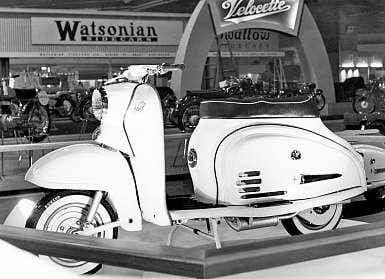
Rather late in the day the Sun Cycles and Fittings Company Ltd entered the scooter market with the Villiers 6F powered 99cc Geni in 1957. In itself, a pleasant little machine, but it suffered from an identity crisis as it sported 15in wheels and a foot change gearshift. Two years later came the Sun Wasp or ‘Sunwasp’ as quoted in some literature, which, despite sharing its name with the Sun Wasp motorcycle, was a scooter in every sense of the word – and, in fact, a jolly good one too.
In a sensible production cost-saving exercise the Sun Wasp scooter shared its main bodywork/chassis and fan cooled three-speed 173cc Villiers 2L engine with the rival Dayton Flamenco and Panther Princess scooters. There were variations between the three marques to maintain brand individuality but many parts were interchangeable. Bizarrely the three makers used different electrics, Dayton – Wipac, Panther – Lucas and Sun – Miller.
As Sun production wound down the Geni was dropped in 1959. Fred Parkes – after 48 years in the chair – retired in mid-1961 and a few months later the business was sold to the Raleigh Industries Group; probably for the cycle business that was rolled into the Carlton cycle works at Nottingham. The Sun Wasp remained the last powered Sun in production and was listed into the 1962 season.
There is no doubting the value of Sun’s contribution to the British and many overseas motorcycle industries. Sun’s work not only lives on in the many surviving Sun models but in countless other light to medium weight models lurking in our workshops.



